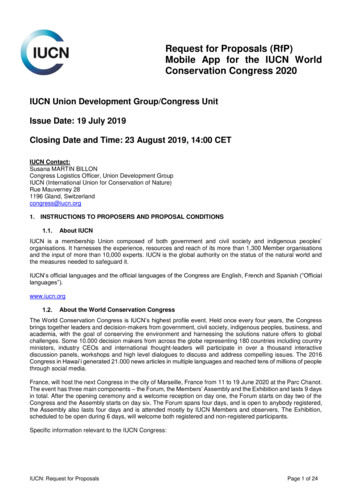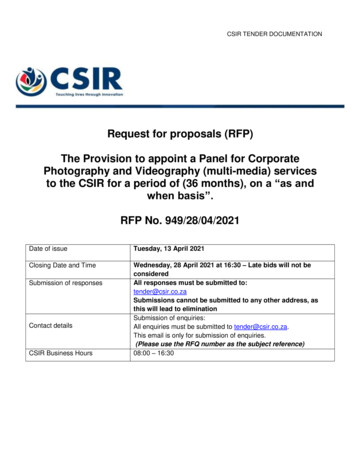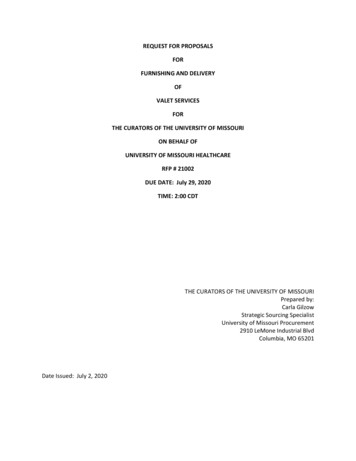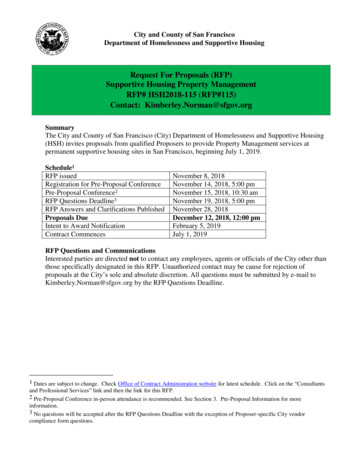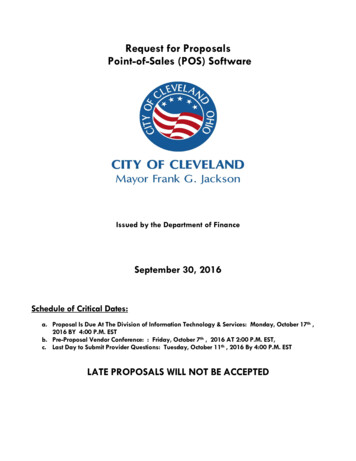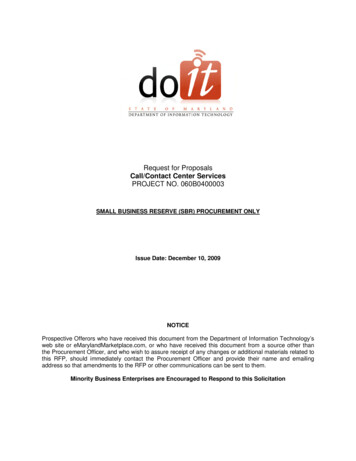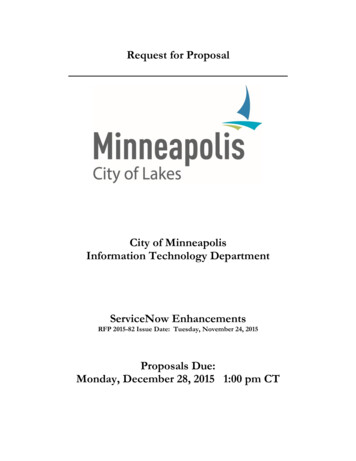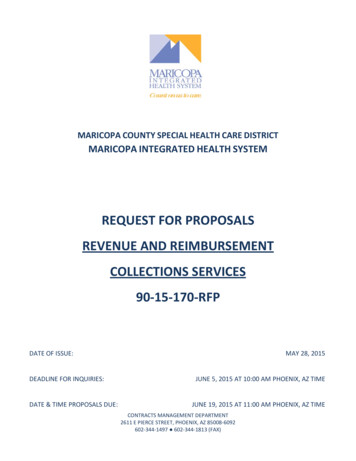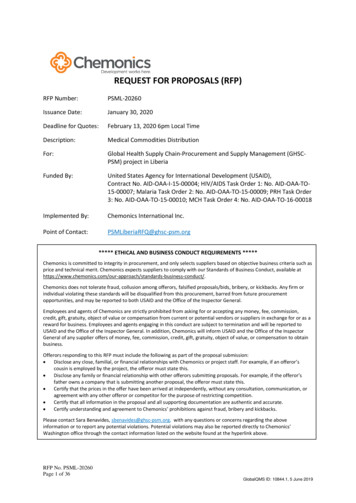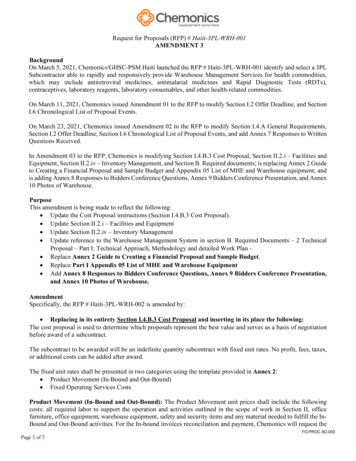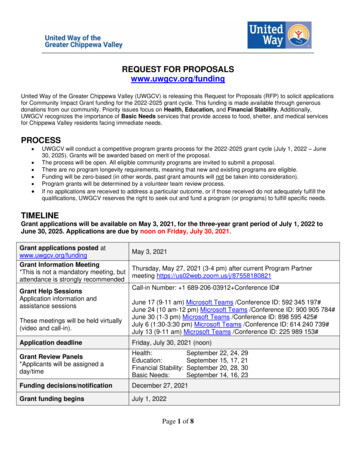
Transcription
REQUEST FOR PROPOSALSwww.uwgcv.org/fundingUnited Way of the Greater Chippewa Valley (UWGCV) is releasing this Request for Proposals (RFP) to solicit applicationsfor Community Impact Grant funding for the 2022-2025 grant cycle. This funding is made available through generousdonations from our community. Priority issues focus on Health, Education, and Financial Stability. Additionally,UWGCV recognizes the importance of Basic Needs services that provide access to food, shelter, and medical servicesfor Chippewa Valley residents facing immediate needs.PROCESS UWGCV will conduct a competitive program grants process for the 2022-2025 grant cycle (July 1, 2022 – June30, 2025). Grants will be awarded based on merit of the proposal.The process will be open. All eligible community programs are invited to submit a proposal.There are no program longevity requirements, meaning that new and existing programs are eligible.Funding will be zero-based (in other words, past grant amounts will not be taken into consideration).Program grants will be determined by a volunteer team review process.If no applications are received to address a particular outcome, or if those received do not adequately fulfill thequalifications, UWGCV reserves the right to seek out and fund a program (or programs) to fulfill specific needs.TIMELINEGrant applications will be available on May 3, 2021, for the three-year grant period of July 1, 2022 toJune 30, 2025. Applications are due by noon on Friday, July 30, 2021.Grant applications posted atMay 3, 2021www.uwgcv.org/fundingGrant Information MeetingThursday, May 27, 2021 (3-4 pm) after current Program Partner*This is not a mandatory meeting, butmeeting https://us02web.zoom.us/j/87558180821attendance is strongly recommendedCall-in Number: 1 689-206-03912 Conference ID#Grant Help SessionsApplication information andJune 17 (9-11 am) Microsoft Teams /Conference ID: 592 345 197#assistance sessionsJune 24 (10 am-12 pm) Microsoft Teams /Conference ID: 900 905 784#June 30 (1-3 pm) Microsoft Teams /Conference ID: 898 595 425#These meetings will be held virtuallyJuly 6 (1:30-3:30 pm) Microsoft Teams /Conference ID: 614 240 739#(video and call-in).July 13 (9-11 am) Microsoft Teams /Conference ID: 225 989 153#Application deadlineFriday, July 30, 2021 (noon)Grant Review Panels*Applicants will be assigned aday/timeHealth:Education:Financial Stability:Basic Needs:Funding decisions/notificationDecember 27, 2021Grant funding beginsJuly 1, 2022September 22, 24, 29September 15, 17, 21September 20, 28, 30September 14, 16, 23Page 1 of 8
GENERAL INFORMATION & ELIGIBILITY REQUIREMENTS: Organizations may apply for multiple grants, but only one grant per program.Your organization may apply in more than one of UWGCV’s Initiatives (Health/Education/Financial Stability/BasicNeeds). Your organization may also submit separate applications for multiple programs under one initiative.UWGCV grant requests may represent no more than 50% of the program’s budget for Chippewa and EauClaire counties (The other 50% of the program budget may include in-kind contributions/services).Applicants must comply with the following policies: Affiliation and Compliance Policy, Anti-Terrorism Policy,Designation Policy, and Fundraising Policy (See www.uwgcv.org/policy-procedure).Programs must have appropriate management and facilities for delivering their services.Programs must have E-mail and Internet capabilities.Programs that receive funding will be required to submit an Annual Progress Report (APR).FUNDING PRIORITY:COMMUNITY IMPACTThe Community Impact model offers a focus on areas of need, gaps in service, and shared outcomes. Health, Education,Financial Stability, and Basic Needs are the cornerstone of this collective model that will result in systematic changeleading to a stronger community. Within the Health, Education, and Financial Stability Initiatives, funded programs willprovide a network of services working toward a common goal. Collecting and reporting data on the shared outcomes andoutcome indicators of the Initiative will be a requirement of the grant (see Initiative information on pages 3-7 for moreinformation on bold goals, shared outcomes, outcome indicators, and other Initiative requirements). Additionally, allprograms who receive grant funding from UWGCV will be required to collect and submit client-perspective data.ALICEThe United Way ALICE (Asset Limited, Income Constrained, Employed) report illustrates that approximately one-third ofall households in Chippewa (32%) and Eau Claire (39%) counties do not earn enough to be self-sufficient. Many of thesehouseholds are ineligible for government programs and a single setback could tip the balance and begin a slide intopoverty. To increase access to services for ALICE and poverty level households, UWGCV funding should target residentsof communities within Chippewa and Eau Claire counties with household income below the ALICE threshold. The ALICEthreshold, approximately 250% of the Federal Poverty Level, is the amount of income needed to support the basic cost ofliving as shown on the Household Survival Budget (see tables on page 8). To learn more about the United Way ALICEreport visit https://www.uwgcv.org/meet-alice or to obtain a copy of the report see 2020 Alice Report.SERVICE DELIVERYUWGCV encourages a countywide focus — with recognition of service to both our urban and rural communities withinChippewa and/or Eau Claire counties.COLLABORATIONCollaboration is working together to achieve common goals, with a deep, collective determination to reach sharedobjectives. UWGCV would like to increase collaboration throughout the Chippewa Valley, resulting in a cooperative web ofservices that addresses community needs. We believe teams consisting of organizations and key individuals, workingcollaboratively, can make more efficient use of resources and have a better chance of achieving outcomes withmeaningful, lasting results. That network becomes even stronger when nonprofit agencies and a variety of other groupscan band together to formalize relationships focused on making a significant difference in the lives of people in Chippewaand Eau Claire counties.To that end, applications for Health, Education, Financial Stability, and Basic Needs must include collaborative partners(not just referral relationships). Although we ask that a “lead organization” be identified, applications must demonstratethat each collaborative partner contributes to the success of the program by supplying expertise, human or otherresources, and/or financial support. It is also important that common measurement tools be established and utilized tocollect data so that the information can be reported and shared with others in the community.Page 2 of 8
Health InitiativeHEALTH APPLICATIONBOLD GOAL: Mental Health of Chippewa Valley residents will improve by utilizing prevention and intervention programs.TARGET POPULATION: Individuals and families with emphasis on — households at or below the ALICE threshold.The Health Initiative is seeking applications for programs that provide mental health support to individuals and/or familiesthrough prevention and/or intervention services. Programs that apply for funding through the Health Initiative mustmeasure and report annually on Outcome 1 or Outcome 2. Additionally, the program is required to measure at least threeof the four outcome indicators in either Outcome 1 or Outcome 2.OUTCOMES - Select only one outcome to measure for the grant. Outcome 1: PREVENTION - Individuals and/or families will increase protective factors* and/or decrease riskfactors** to support mental health. Outcome 2: INTERVENTION - Individuals and/or families will demonstrate the ability to effectively manage lifemental health challenges.OUTCOME INDICATORS - Programs must measure at least three of the four indicators. Indicator 1:Indicator 2:Indicator 3:Indicator 4:# and % of individuals who identify at least one healthy supportive relationship# and % of individuals who actively utilize at least one healthy coping skill# and % of individuals who decrease/abstain from risky behaviors# and % of individuals who develop an effective safety planSTRATEGIES: Below are examples of strategies (other strategies can be applied). Build supportive relationships Assist individuals to identify their effective coping style Provide services to families in their own communities Connect individuals to needed resources in a strength-based mannerMETHODOLOGY: Below are examples of methods to implement the strategies (other methods can be applied). Counseling Crisis Intervention Mentoring Peer Support School-Based Mental Health Services*Protective factors: conditions or attributes (skills, strengths, resources, supports, or coping strategies) in individuals,families, communities, or the larger society that help people deal more effectively with stressful events and mitigate oreliminate risk in families and communities.**Risk factors: a condition, behavior, or other factor that increases risk of disease.If you have any questions, please call Isabella Hong at 715-834-5043 or contact health@uwgcv.org.Page 3 of 8
Education InitiativeBold Goal: Children in the Chippewa Valley will enter school ready to succeed.Target Population: Children ages zero to five, in households at or below the ALICE threshold.The Education Initiative is seeking applications for programs that provide support to children andparents/guardians/caregivers in the defined outcomes. All programs that receive funding will be required to measure andreport annually on Outcome 1 and/or Outcome 2.Shared Outcomes – Must measure Outcome 1, Outcome 2, or both.Outcome 1: Children in the target population will demonstrate optimum development in the following areas: Health and physical well-being Social and emotional development Language development and general knowledge.Outcome 1 Indicators: # and % of children who displayed developmental growth in health and physical well-being. # and % of children who displayed developmental growth in social and emotional development. # and % of children who displayed developmental growth in language development and generalknowledge.Outcome 2: Parents/guardians/caregivers will provide supportive environments for children in the target population.Outcome 2 Indicators: # and % of participants who demonstrate and/or report an increased understanding of parenting/caregiving skills. # and % of participants who demonstrate and/or report an increased understanding of child development. # and % of participants who demonstrate and/or report an increased understanding of available supportsand resources.If you have any questions, please call Isabella Hong at 715-834-5043 or contact education@uwgcv.org.Page 4 of 8
Financial Stability InitiativeBold Goal: Chippewa Valley residents will achieve self-sufficiency* through employment training and personal moneymanagement skills.Target Population: Chippewa Valley residents, from middle school through approximately age 55**.Program Overview: The Financial Stability Initiative is seeking applications for programs that provide 1 or more of thefollowing: employment skills, training, financial literacy education, and programs that address coordination and/orexpansion of services in those areas. The following are examples of strategies to serve the target population.Middle and High School students and students up to the age of 21 with an IEP:Facilitate the development and/or enhancement of programs to: Teach “soft skills” (i.e., teamwork, problem-solving, decision-making, interpersonal communication, and criticalthinking). Teach personal money management skills (e.g., use of checking and savings accounts, credit card use andcredit score, debt management, investment, and budgeting). Assist youth in understanding the earning potential of employment training over a lifetime and expose youth tohigh demand occupations (e.g. intern programs and/or school-to-work programs). Assist youth in obtaining a credential (e.g. GED/HSED, nursing assistant certification, registered/youthapprenticeships, etc.).Unemployed adults or those in low-paying jobs, who need help to advance:Facilitate the development and/or enhancement of programs to: Teach “soft skills” (i.e., teamwork, problem-solving, decision-making, interpersonal communication, and criticalthinking). Teach personal money management skills (e.g., use of checking and savings accounts, credit card use andcredit score, debt management investment, and budgeting) through financial counseling/coaching, and work withparticipants on debt reduction so that participants have unsecured debt at or below 10% of net income and totaldebt at or below 40% of net income. Assist adults in understanding the earning potential of employment training over a lifetime and expose adults tohigh demand occupations (e.g. intern programs and/or school-to-work programs). Assist adults in obtaining a credential (e.g. GED/HSED, nursing assistant certification, registered/youthapprenticeships, etc.) and/or a post-secondary degree.Note: Current high demand occupations for the Chippewa Valley include: Advanced Manufacturing, Skilled Trades,Healthcare, Information Technology, Education, Transportation, and Protective Services.Required Measures and Reporting: Programs that apply for funding through the Financial Stability Initiative mustmeasure and report annually on outcome 1, outcome 2, or both (see shared outcomes). Programs must use the outcomeindicators listed and may supply additional data or information. Scoring preference will be given to programs that canaddress both outcome 1 and outcome 2. This data may be collected individually by the program applying for funds orthrough a collaboration with another program or organization. All programs must collect information from clients to answerseveral shared questions, and report on the shared questions annually to UWGCV. When programs receive funding,UWGCV will schedule an orientation to review understandings of goals. Finally, all programs that receive funding throughthe Financial Stability Initiative, to work with adults (18 and older), will be required to track baseline and annual data onthe following: Household composition and household income.Participant income upon admission and participant income upon discharge of the program.Participant debt upon admission and participant debt upon discharge of the program.Other community resources utilized by individual participants (Food Share, Medicaid, nonprofit organizations,etc.).Page 5 of 8
Shared Outcomes:Outcome 1: Individuals who face financial challenges will have a steady source of income that allows them tomeet basic needs and increase disposable income.Contributing Outcome A: Individuals who face financial challenges will have the general education and softskills needed to obtain gainful employment.Outcome 1A Indicators: # and % of participants placed in intern programs # and % of participants placed in school-to-work programs # and % of participants exposed to high demand occupations # and % of participants who understand the earning potential of employment training (e.g.registered/youth apprenticeship, certificate, post-secondary education) over a lifetime # and % of participants who improved soft skills in the following areas: Teamwork Problem-solving Decision-making Interpersonal communication Critical thinkingContributing Outcome B: Individuals who face financial challenges will have the job skills needed to further theircareers.Outcome 1B Indicators: # and % of participants who obtained a credential (e.g. GED/HSED; registered/youth apprenticeship;Certified Nursing Assistant) # and % of participants who obtained a post-secondary degree # and % of participants who made progress toward a post-secondary degree as indicated by achieving apassing grade in 15 credits within one yearOutcome 2: Individuals will have effective personal money management skills.Outcome 2 Indicators: # and % of participants with unsecured debt at 10% or less of net income # and % of participants with total debt at 40% or less of net income # and % of participants who understand what it means to save and invest # and % of participants exposed to high demand occupationsShared questions: Your answers may be used anonymously by UWGCV to demonstrate program success.1. As a result of the program, has your situation improved? Yes or no and explain.2. Do you feel better able to manage your money? Yes or no explain.3. Has the program assisted you in making progress toward personal financial stability? Yes or no and explain.*self-sufficiency is quantified through the United Way ALICE Report.**for programs working with adults, target population is focused on adults at or below the ALICE threshold.If you have any questions, please call Kelly Christianson at 715-834-5043 or contact financialstability@uwgcv.org.Page 6 of 8
Basic NeedsBold Goal: Chippewa Valley residents will have access to food, shelter, and medical services in their time of need.Target Population: Households living at or below the ALICE threshold.While the community works to address the root causes of important community issues, we realize that there areindividuals in our region who need our support right now. That’s why UWGCV provides funding to fulfill basic needs suchas food, shelter, health, and safety. When individuals are unable to meet their immediate needs, it becomes more difficultto focus on long-term goals such as employment, housing, or education. When a crisis occurs, UWGCV is there providingthose in need with services and assistance to bring the stability they need to get back on track.Basic Needs grants are meant to fund intervention-related activities that address short-term client needs (as opposed tothe Community Impact long-term prevention-related strategies in the focus areas of Health, Education and FinancialStability).Basic Needs grants are meant to serve people who have had a temporary setback or who face emergency situations. Thegoal is to provide immediate, short-term assistance to help people stabilize their situation or recover from the emergencyand continue on their journey toward a better quality of life.Programs seeking grants in the Basic Needs focus area are required to collaborate with other programs that helptransition these clients beyond basic needs assistance and help them move toward long-term self-sustainability.Eligible Services: Food – includes groceries and meals. Shelter/Housing – includes sleeping, transitional, warming, and personal hygiene facilities, as well as rentalassistance. Medical care – includes basic health care and prescriptions, and basic dental care and prescriptions. Programs that enhance access to the above services.General Evaluation CriteriaThe proposed program aligns with the target population and one or more of the eligible service areas: The proposal identifies an efficient use of financial resources.The proposal addresses accessibility-how potential barriers to access are addressed (hours, location, social,ethnic, transportation, etc.).The proposal addresses the context of why services are needed, what services are available, who the servicesare available to.The program and its strategic collaborative partner(s) can leverage adequate funds and resources to affect theissue.The program will provide data on unique individuals and services provided.If you have any questions, please call Kelly Christianson at 715-834-5043 or contact basicneeds@uwgcv.org.Page 7 of 8
Page 8 of 8
UWGCV will conduct a competitive program grants process for the 2022-2025 grant cycle (July 1, 2022 – June 30, 2025). Grants will be awarded based on merit of the proposal. The process will be open. All eligible community programs are invited to submit a proposal.
